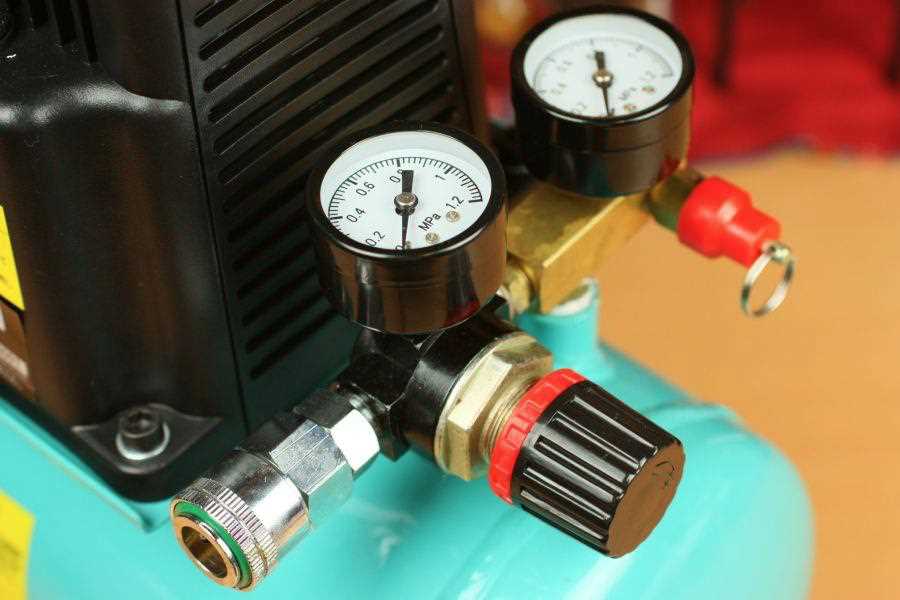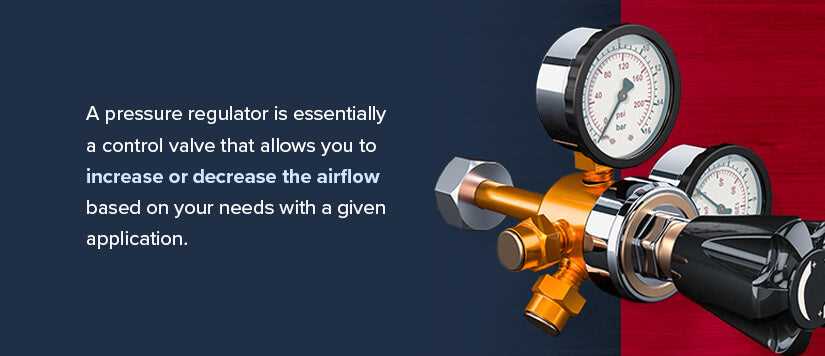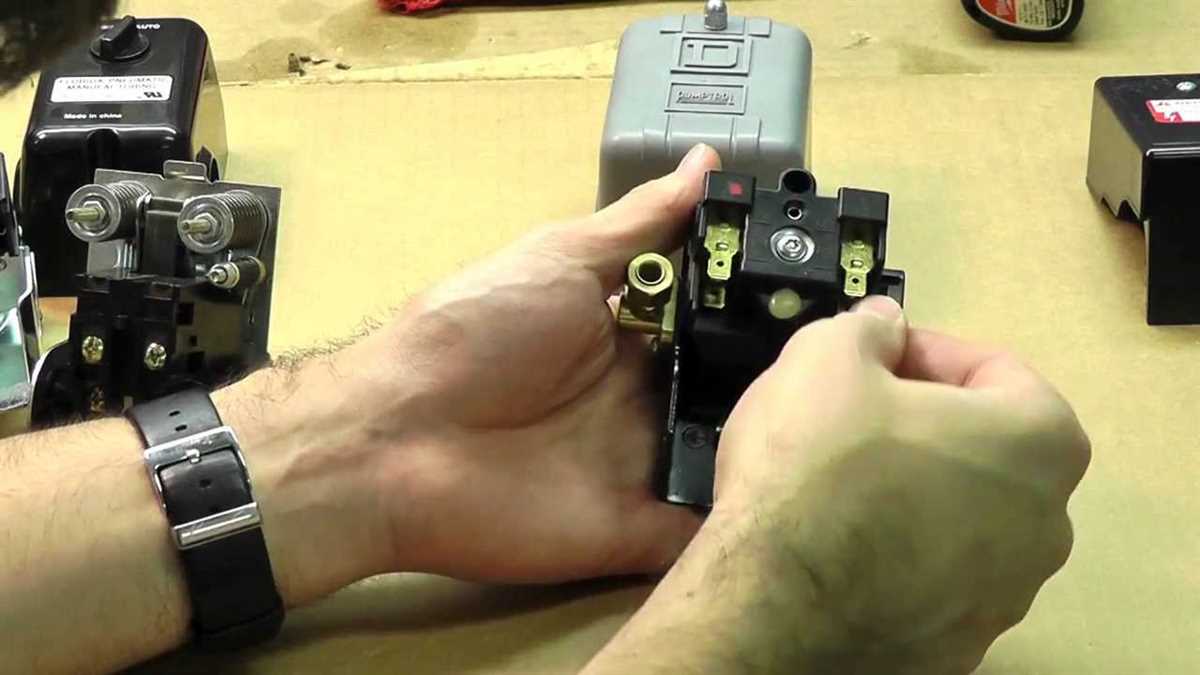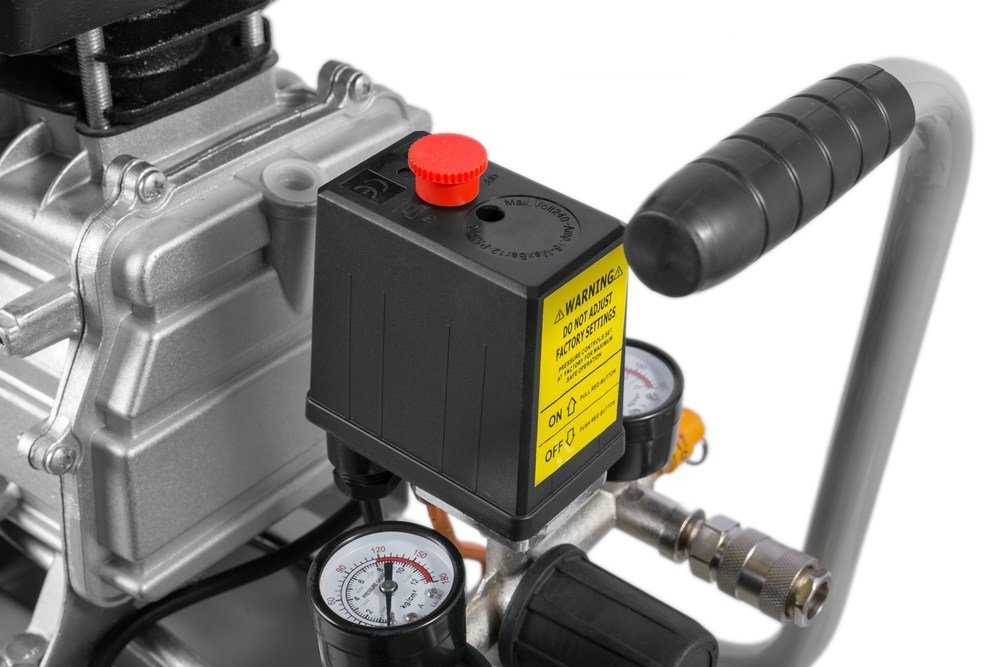How to Adjust the Pressure Regulator on an Air Compressor

An air compressor is a valuable tool to have in your workshop or garage, as it can power a wide range of pneumatic tools. However, in order for your compressor to function properly and safely, it’s important to adjust the pressure regulator to the correct settings.
The pressure regulator on an air compressor is responsible for controlling the amount of pressure that is released from the tank. This is important because different tools and applications require different levels of pressure. For example, a nail gun may require a lower pressure, while a paint sprayer may need a higher pressure.
To adjust the pressure regulator, you will first need to locate it on your air compressor. It is usually located near the tank and is marked with pressure measurements in PSI (pounds per square inch). Once you have found the regulator, you can use a wrench or screwdriver to adjust the pressure settings.
It’s important to note that you should always consult the manufacturer’s instructions for your specific air compressor model, as the exact steps for adjusting the pressure regulator may vary. However, in general, you will need to turn the adjustment knob clockwise to increase the pressure and counterclockwise to decrease it. It is recommended to make small adjustments and test the pressure with a gauge to ensure it is at the desired level.
By properly adjusting the pressure regulator on your air compressor, you can ensure that your tools and applications are receiving the correct amount of pressure for optimal performance. This will not only extend the lifespan of your tools but also help prevent any safety risks associated with using an air compressor. Remember to follow the manufacturer’s instructions and make small adjustments as needed to achieve the desired pressure settings.
What is an Air Compressor
An air compressor is a mechanical device that converts power (usually from an electric motor, diesel engine or gasoline engine) into potential energy stored in pressurized air. The air compressor forces more and more air into a storage tank, increasing the pressure inside. This pressurized air can then be used for a variety of purposes.
How does an Air Compressor work?
An air compressor works by using a motor or engine to increase the pressure of the air, which is then stored in a tank. The compressor draws in air from the surroundings and compresses it to a higher pressure. This compressed air is then stored in the tank until it is needed.
When the compressed air is released from the tank, it can be used to power tools and equipment, such as pneumatic drills, nail guns, and paint sprayers. The pressure regulator on the air compressor allows the user to adjust the pressure of the released air, depending on the requirements of the task at hand.
Why use an Air Compressor?
There are several reasons why an air compressor is a useful tool. Firstly, it provides a portable source of power. With a portable air compressor, you can power tools and equipment anywhere, without the need for electricity or cords.
Secondly, air compressors are known for their versatility. The compressed air can be used for a wide range of applications, including inflating tires, operating air-powered tools, cleaning debris, and even powering vehicles. The adjustable pressure regulator allows for precise control over the amount of air and pressure needed for specific tasks, making the air compressor a flexible tool for various industries.
Lastly, air compressors are relatively low maintenance and have a long lifespan when properly maintained. Regular maintenance, such as changing filters and oil, can ensure the compressor operates efficiently and prolong its life.
Conclusion
An air compressor is a valuable tool that converts power into stored potential energy in the form of pressurized air. With its ability to provide portable power and versatility in various applications, an air compressor is a must-have for many industries and DIY enthusiasts. The pressure regulator on the air compressor allows for precise control over the pressure of the released air, ensuring optimal performance for different tasks.
Importance of Pressure Regulation
Pressure regulation is a critical aspect of operating an air compressor effectively and safely. The pressure regulator on an air compressor allows you to control and adjust the output pressure, ensuring that it remains within the desired range. This is important for various reasons.
Safety
Proper pressure regulation is essential for ensuring the safety of both the operator and the equipment. If the pressure is set too high, it can pose a significant safety risk, leading to equipment damage, leaks, or even explosions. By adjusting the pressure regulator, you can ensure that the air compressor operates at a safe pressure level, minimizing the risk of accidents and malfunctions.
Equipment Longevity
The pressure at which an air compressor operates has a direct impact on the lifespan of the equipment. Too much pressure can put excessive strain on the compressor, causing components to wear out quickly or fail prematurely. On the other hand, operating at too low pressure can lead to inefficient performance and increased wear on the compressor. Proper pressure regulation allows you to optimize the compressor’s performance and extend its lifespan.
Energy Efficiency
Adjusting the pressure regulator on an air compressor can also help improve energy efficiency. Operating at a higher pressure than necessary results in unnecessary energy consumption. By optimizing the pressure to the specific application requirements, you can reduce energy waste and lower operating costs. This is especially important in industrial settings where air compressors are used extensively.
Consistent Performance
Keeping the pressure within the desired range ensures consistent and reliable performance of the air compressor. Different applications may require different pressure levels, and by adjusting the regulator accordingly, you can achieve the desired output consistently. Consistent pressure also helps maintain the quality of the end product, especially in industries such as painting or pneumatic tools operations.
In conclusion, pressure regulation is of utmost importance when it comes to operating an air compressor efficiently and safely. It ensures safety, prolongs the lifespan of the equipment, improves energy efficiency, and allows for consistent performance. By understanding how to adjust the pressure regulator and keeping it properly maintained, you can optimize the performance of your air compressor and enhance overall productivity.
Step 1: Safety Precautions
Before adjusting the pressure regulator on an air compressor, it is important to take certain safety precautions to ensure your well-being and prevent any potential accidents or injuries.
1. Wear Safety Gear: Always wear appropriate safety gear, such as safety glasses, gloves, and ear protection, when working with an air compressor. This will protect you from any flying debris or loud noises that may occur.
2. Disconnect Power Supply: Prior to adjusting the pressure regulator, make sure to disconnect the power supply to the air compressor. Unplugging it from the electrical outlet or shutting off the breaker will prevent any accidental start-up or electric shock.
3. Release Pressure: Next, release the pressure from the air compressor by turning the drain valve counterclockwise. This will ensure that there is no residual pressure in the system, which can be dangerous when making adjustments.
4. Locate the Pressure Regulator: Identify the pressure regulator on your air compressor. It is typically located near the tank or on the control panel. Familiarize yourself with its components and how it operates before attempting to adjust it.
5. Read the Manual: Consult the manufacturer’s manual or instructions for your specific air compressor model. This will provide you with the necessary information and guidelines for adjusting the pressure regulator correctly and safely.
By following these safety precautions, you can ensure a safe working environment and minimize the risks associated with adjusting the pressure regulator on an air compressor.
Preparing the Work Area
Before adjusting the pressure regulator on an air compressor, it is important to prepare the work area to ensure safety and efficiency. Here are a few steps to take before starting the adjustment process:
Clean the work area:

Clear any debris or clutter from the work area to create a safe and organized environment. This will help prevent accidents and ensure that there is enough space to access the air compressor.
Check for proper ventilation:
Make sure the work area is well-ventilated to prevent the buildup of fumes. Good air circulation is essential, especially when working with compressed air, to maintain a safe working environment.
Inspect the air compressor:
Before beginning the adjustment, visually inspect the air compressor for any signs of damage or wear. Check for loose connections, leaks, or any other potential issues. If any problems are detected, address them before proceeding with the adjustment.
Wear protective gear:
Always wear appropriate protective gear, such as safety glasses and gloves, when working with air compressors. This will help protect against potential hazards, including flying debris or contact with pressurized air.
By taking these steps to prepare the work area, you can ensure a safe and efficient adjustment of the pressure regulator on your air compressor.
Personal Protective Equipment
Personal protective equipment (PPE) is essential when working with an air compressor to ensure the safety of the operator. PPE helps protect against potential hazards such as high-pressure air, flying debris, and noise. It is important to use the appropriate PPE to minimize the risk of accidents or injuries.
1. Safety Glasses or Face Shield
One of the most important pieces of PPE when working with an air compressor is safety glasses or a face shield. These protect the eyes from any flying debris or particles that may be discharged from the compressor. Safety glasses or a face shield should always be worn to prevent eye injuries.
2. Hearing Protection
Due to the loud noise produced by an air compressor, it is important to wear hearing protection. This can include earplugs or earmuffs that effectively reduce the noise levels to protect the operator’s hearing. Prolonged exposure to high noise levels can cause hearing damage, so wearing hearing protection is crucial.
3. Gloves
Gloves are another essential piece of PPE when working with an air compressor. They protect the hands from potential injuries such as cuts, abrasions, or contact with hot surfaces. It is recommended to wear gloves that are specifically designed for working with air compressors, as they provide better grip and protection.
4. Respiratory Protection

Depending on the environment and the type of air compressor being used, respiratory protection may be required. This can include dust masks or respirators that filter out harmful particles in the air, ensuring the operator’s respiratory health. It is important to assess the air quality and potential hazards before deciding on the appropriate respiratory protection.
5. Protective Clothing
When operating an air compressor, it is important to wear appropriate protective clothing that covers the body. This includes long-sleeved shirts, long pants, and closed-toe shoes. Protective clothing helps prevent any potential injuries to the skin from flying debris or accidental contact with the compressor.
In conclusion, personal protective equipment is crucial when working with an air compressor. Safety glasses or a face shield, hearing protection, gloves, respiratory protection, and protective clothing are all important PPE to protect the operator from potential hazards. Remember to properly assess the risks and choose the appropriate PPE to ensure a safe working environment.
Step 2: Identify the Pressure Regulator
The pressure regulator is an important component of an air compressor. It is responsible for controlling and adjusting the pressure level of the compressed air that is delivered to the tools and equipment. Before making any adjustments, it is crucial to identify the pressure regulator on your air compressor.
Locate the pressure regulator: The pressure regulator is usually located near the air outlet of the air compressor. It can be identified by a knob or dial that is used to adjust the pressure settings.
Inspect the pressure regulator: Take a close look at the pressure regulator to ensure that it is in good condition. Check for any signs of damage or wear, such as cracks or leaks. If you notice any issues, it may be necessary to replace the pressure regulator before making any adjustments.
Familiarize yourself with the pressure settings: The pressure regulator will have numerical markings or pressure units, indicating the desired pressure level. Take note of the current pressure setting before making any adjustments. This will help you maintain consistency and avoid over or under-pressurizing your tools and equipment.
Refer to the manufacturer’s instructions: Some air compressors may have specific instructions or diagrams to help you identify the pressure regulator. If you are unsure about the location or operation of the pressure regulator, consult the manufacturer’s manual or website for guidance.
Locating the Pressure Regulator

Before adjusting the pressure regulator on an air compressor, you need to first locate it. The pressure regulator is a device that controls the air pressure coming out of the compressor. It is typically located near the outlet or on the control panel of the air compressor.
When looking for the pressure regulator, you may need to consult the owner’s manual or check the manufacturer’s website for specific instructions on its location. In some cases, the pressure regulator may be labeled or color-coded to make it easier to identify.
If you are unable to locate the pressure regulator, you may want to consider seeking assistance from a professional or contacting the manufacturer for further guidance. It is important to exercise caution when working with air compressors to prevent injury or damage to the equipment.
Understanding the Pressure Adjustment Knob
The pressure adjustment knob is a key component in controlling the pressure output of an air compressor. It is typically located on the regulator, which is the device responsible for regulating and maintaining the desired pressure level in the air compressor system.
The pressure adjustment knob works by controlling the amount of air that is allowed to pass through the regulator. By turning the knob clockwise or counterclockwise, the user can increase or decrease the pressure output of the compressor. It is important to note that the pressure adjustment knob is a sensitive component, and small adjustments can have a significant impact on the pressure level.
Understanding the graduations on the pressure adjustment knob:
The pressure adjustment knob is usually marked with graduations or numbers that indicate the pressure level. These graduations may be in pounds per square inch (PSI) or bar, depending on the air compressor system. The user can refer to these markings to ensure that the pressure is set to the desired level.
How to adjust the pressure using the knob:
- Start by turning off the air compressor and relieving any built-up pressure in the system.
- Locate the pressure adjustment knob on the regulator.
- Using your hand, turn the knob clockwise to increase the pressure or counterclockwise to decrease the pressure.
- Make small adjustments to the knob and wait for the pressure to stabilize before making any further adjustments.
- Refer to the graduations on the knob to ensure that the pressure is set to the desired level.
- Once the desired pressure is achieved, turn on the air compressor and monitor the pressure gauge to ensure that it remains within the desired range.
It is important to note that adjusting the pressure should be done carefully and in small increments to avoid damaging the air compressor system or causing any safety risks. It is recommended to consult the manufacturer’s instructions or seek professional assistance if you are unsure about how to adjust the pressure regulator on your specific air compressor.
Step 3: Adjusting the Pressure Regulator
Now that you have located the pressure regulator on your air compressor, it’s time to adjust it to the desired pressure. The pressure regulator is typically a knob or a dial that controls the amount of pressure that is released from the air compressor.
Here are the steps to properly adjust the pressure regulator:
- Turn off the air compressor: Before making any adjustments, ensure that the air compressor is turned off and that there is no pressure in the tank. This is important for your safety and to prevent any damage to the regulator.
- Identify the desired pressure: Determine the specific pressure that you need for your task. This could be found in the manufacturer’s instructions or recommended pressure guidelines for the tool or equipment you plan to use.
- Turn the pressure regulator clockwise or counterclockwise: Depending on your air compressor model, you may need to rotate the regulator knob clockwise to increase the pressure or counterclockwise to decrease the pressure. Make gradual adjustments until you reach the desired pressure.
- Check the pressure gauge: After each adjustment, check the pressure gauge to see if the desired pressure has been reached. If not, continue making small adjustments until you reach the correct pressure.
- Test the adjusted pressure: Once you have set the pressure on the regulator, turn on the air compressor and test the adjusted pressure using a pressure-sensitive tool or equipment. Ensure that the pressure is suitable for the task at hand.
Remember to use caution and make small adjustments when adjusting the pressure regulator to avoid sudden pressure surges. Always refer to the manufacturer’s instructions for your specific air compressor model. Properly adjusting the pressure regulator will ensure that your air compressor operates efficiently and that you achieve the desired results for your project.
Turning Off the Air Compressor
1. Switch off the power
Before turning off the air compressor, make sure to switch off the power to prevent any accidents or injuries. Locate the power switch or breaker and flip it to the off position.
2. Release the pressure

After switching off the power, it is important to release the pressure in the air compressor to ensure safe operation. This can be done by slowly turning the pressure release valve counterclockwise. Allow the air to escape until the pressure gauge reads zero.
3. Disconnect any attachments or hoses
If you have any attachments or hoses connected to the air compressor, remove them before fully turning off the compressor. This will help prevent any damage to the equipment and make it easier for future maintenance or repairs.
4. Clean and inspect
Once the pressure has been released and all attachments have been disconnected, take the time to clean and inspect the air compressor. Remove any debris or dust from the exterior and inspect the internal components for any signs of wear or damage.
5. Store the air compressor properly
When the air compressor is not in use, it should be stored in a clean, dry, and well-ventilated area. Make sure to follow any specific instructions from the manufacturer regarding storage and maintenance to ensure optimal performance and longevity of the equipment.
FAQ:
Why would I need to adjust the pressure regulator on an air compressor?
You may need to adjust the pressure regulator on an air compressor in order to control the amount of pressure that is being delivered to your tools or equipment. Different tools or applications may require different levels of pressure, so adjusting the pressure regulator allows you to customize the output to suit your needs.
How do I know if my pressure regulator needs adjusting?
If you notice that the pressure being delivered to your tools or equipment is either too high or too low, it may be an indication that your pressure regulator needs adjusting. Additionally, if you are experiencing issues with the performance of your tools, such as decreased power or inconsistent operation, it could be a sign that the pressure regulator needs to be adjusted.
What tools or equipment do I need to adjust the pressure regulator?
To adjust the pressure regulator on an air compressor, you will typically need a wrench or pliers to loosen or tighten the adjustment knob or nut on the pressure regulator. Some air compressors may also have a gauge that allows you to monitor the pressure levels.
Are there any safety precautions I should take when adjusting the pressure regulator?
Yes, there are a few safety precautions you should take when adjusting the pressure regulator on an air compressor. First, always make sure to turn off the air compressor and release any remaining pressure in the system before making any adjustments. This will help prevent any accidental releases of pressurized air. Additionally, it’s important to wear safety goggles and gloves to protect yourself from any potential hazards.
Can I adjust the pressure regulator while the air compressor is running?
No, it is not recommended to adjust the pressure regulator while the air compressor is running. This is because making adjustments while the system is pressurized could be dangerous and may result in injury. It is best to turn off the air compressor and release any remaining pressure before attempting to adjust the pressure regulator.
How do I increase the pressure output from the air compressor?
To increase the pressure output from the air compressor, you will need to turn the adjustment knob or nut on the pressure regulator in a clockwise direction. This will increase the tension and allow more pressure to be delivered to your tools or equipment. It’s important to make small adjustments and test the pressure levels as you go to ensure you don’t exceed the recommended limits.
How do I decrease the pressure output from the air compressor?
To decrease the pressure output from the air compressor, you will need to turn the adjustment knob or nut on the pressure regulator in a counterclockwise direction. This will decrease the tension and restrict the flow of air, resulting in lower pressure being delivered to your tools or equipment. Again, it’s important to make small adjustments and test the pressure levels to achieve the desired output.
Video:











